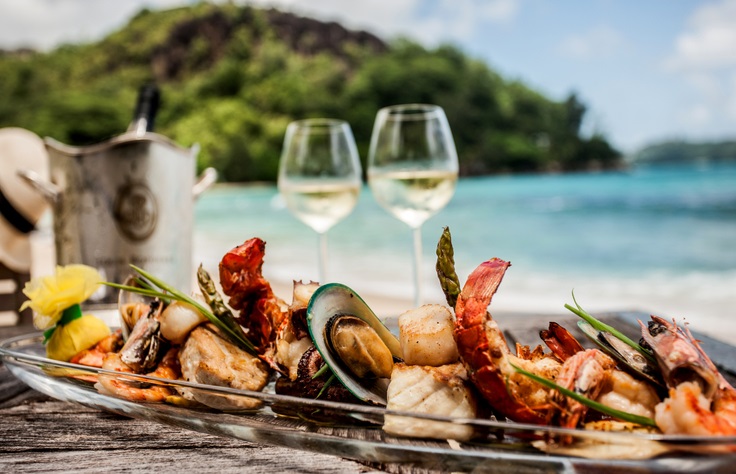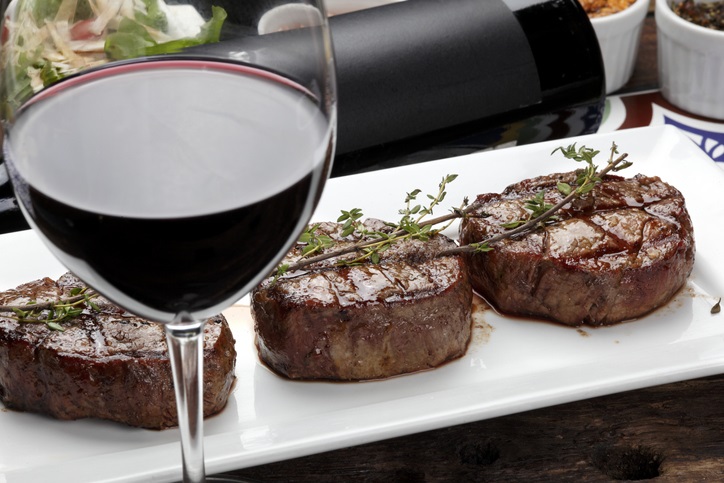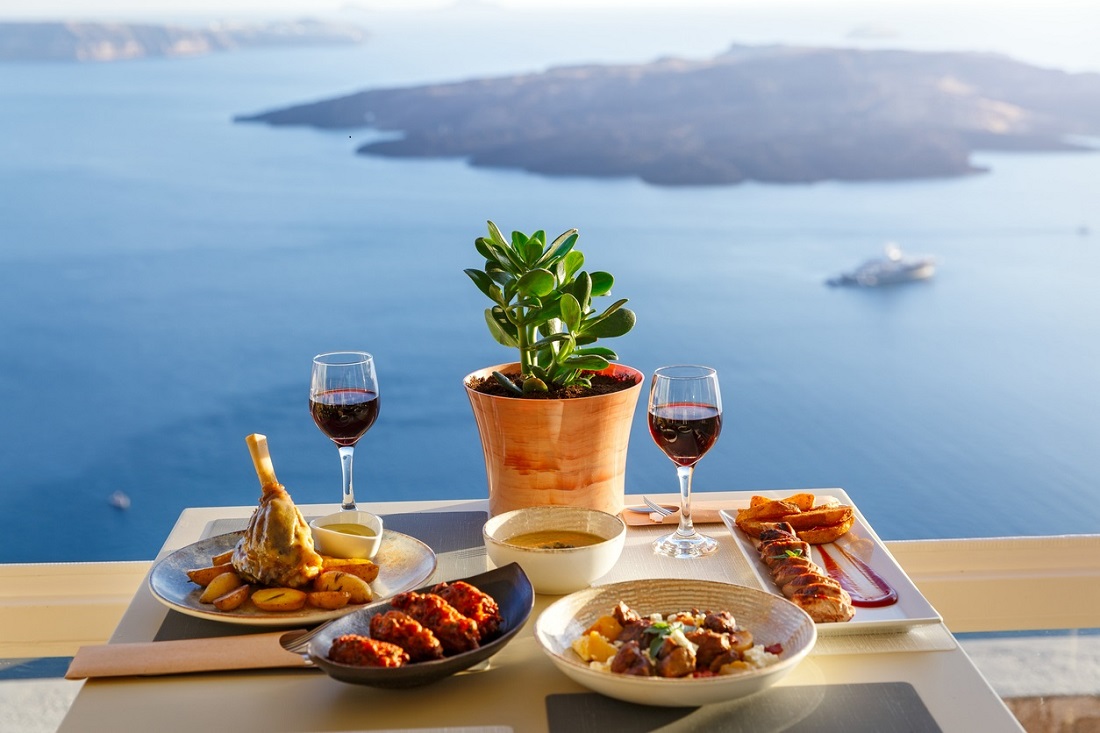Pairing food and wine together can be a transformative experience. While we’re big believers in eating and drinking whatever you like, it’s always fun to experience a pairing that elevates both the wine and the food to make both taste better than initially imagined. This is the primary reason why “wine pairing” is a thing. The pairing can be something so simple that it’s almost exhilarating how well they interact.
And while we don’t want to take the joy out of this all by overthinking, there are some pretty simple guidelines that can help take the guesswork out and allow you to enjoy such experiences of your own.
In general, consider weight, acidity, and boldness of flavor. For example, there’s a deeply rooted belief that red wines can’t be paired with seafood but a boldly spiced seafood dish actually needs a bigger wine because it can overwhelm a white. Similarly, a light white like Pinot Grigio will simply get lost with a beef stew. Here, we explore pairings that bring out the best of both the wine and the dish.
Seafood

Oysters, clams, and mussels
Although we’ve categorized these mollusks together, there are obvious differences between them. Oysters are probably most often served raw and a classic pairing is Melon de Bourgogne from Muscadet, Chablis, or even Champagne.
Clams on the half-shell are slightly sweeter than most oysters and not quite as briny. Sauvignon Blanc is a good match here, though a dry rosé can work too. And of course, who doesn’t love spaghetti alle vongole? This classic southern Italian dish can be created with tomatoes or without but the basics are olive oil, garlic (of course), clams, and pasta. This fresh, clean dish works well with light, dry white wines, like Soave or Vermentino. If tomatoes are involved, a rosé is a better option to pick up those ripe fruit notes.
Mussels can be prepared in such a variety of ways that they can be almost infinitely pairable but for brevity’s sake, we’ll focus on the most common preparations. The classic moules frites works well with Chablis or Muscadet because both have lighter fruit notes and high enough acidity to work with the French fries. Mussels prepared with a red sauce are better served by a rosé.
Shrimp, scallops, crabs, lobster
We’ve grouped these four together because the meat of each tends to be similar in texture and in sweetness level so the biggest consideration in pairings is the preparation method. Chardonnay, whether it’s oaked or not, is a great pairing for all because it’s got bold acidity that works with the richness of the meat. Buttery Chardonnays will melt right into lobster with butter sauce, while leaner Chablis loves scallops. For slightly spicier dishes, like crabcakes or garlic shrimp, Godello is a good fit. It’s bolder and has a lovely roundness to it that balances both spice and weight.
Whitefish, including bass
In general, different types of white fish tend to be light and delicate so wine is paired accordingly. Pinot Grigio, Albariño, and Sauvignon Blanc will all work well, depending on the preparation. For fish with a richer sauce, like sole meunier or a cream-based sauce, we can go with a weightier white like Chardonnay or Chenin Blanc. Sea bass tends to have quite a bit of heft to it, so there we can think more towards Chardonnay or even white Rhône blends. Most white fish will be overpowered by red wine.
For fried fish, be sure to go with higher acidity. Sauvignon Blanc is a good choice here because it’s a bit weightier than Pinot Grigio and has the acidity to balance out the fry. It also works very well with tartar sauce because the green notes match well.
Salmon and tuna
Salmon, particularly if it’s prepared with a cream sauce, works with Chardonnay or Viognier. Basically, a weightier white that highlights the natural sweetness of the fish is a good fit there. Smoked salmon works better with Grüner Veltliner or Riesling because the bold flavors balance out. Grilled salmon can work better with a deep rosé or a Pinot Noir. Tuna is another heftier fish that is versatile and it works really well with red wine. Grilled tuna steak pairs well with Loire Valley Cabernet Franc because of the earthier notes in both. For a niçoise salad, go with a rosé because it’s more versatile and can pair with the many ingredients.
RELATED: Ultimate Guide to Pairing Wine with Sushi
Poultry
Chicken, game hen, pheasant
Chicken is almost like a blank canvas because it really is all about preparation. Fried chicken is notoriously wonderful with Champagne or other sparkling wine (seriously, try it). Chicken stew prefers Chardonnay or a similar white with some richness to it. Roast chicken can handle red wine, particularly if herbs like rosemary and thyme are involved. Go for aromatic herbal red Rhône. Barbecued chicken can take on the big guns like Zinfandel, though a Grenache will be a better match if the sauce isn’t too spicy.
Turkey
We don’t really think about turkey too much beyond the holidays which is a shame because it’s incredibly wine-friendly. Turkey can handle everything from Riesling to Syrah. Leftover turkey is often transformed into turkey croquettes or some sort of pot pie; there, we can go with a higher acid white or red, like Chenin Blanc or Pinot Noir.
RELATED: In-depth Guide to Pairing Wine with Turkey for Thanksgiving
Duck
Duck is darker and richer than both chicken and turkey so it’s a natural pairing for more deeply flavored reds. Red Rhônes work incredibly well with duck because they tend to complement the gamey quality without making it too pungent. Cassoulet, although not exclusively duck, loves the earth and fruit of Syrah.
Pork
Pork really is the other white meat, as the old ad campaign goes, and it’s similar to chicken in that it’s more about preparation than the meat itself.
Pork meat has a natural sweetness to it that heightens when roasted. Whether we’re working with a loin or chops, simple preparation still allows plenty of flavor to come forward. Riesling is a fantastic partner for pork because it plays off the sweetness while still keeping it all in check with acidity. Bacon is allllll about fat, and that’s a good thing! Pairings with bacon revolve around the level of char, salt, and fat. Grenache works really well, and Pinotage can as well because it typically displays a meaty note. Pork sausage is such a broad category because seasoning can be anything from benign – think fennel and apple – to very bold, like chorizo. Mild sausage can pair well with Riesling or Gewürztraminer while boldly seasoned sausage is a much better fit with southern French blends or Italians like Sangiovese. Finally, we admit that beer is probably the best pairing for pulled pork but if you really want wine, stick to big, bold reds. Zinfandel is a good fit because it’s got the weight to stand up to the spice of pulled pork.

Steak & Beef
Perhaps the quintessential American dish is a burger and fries. And while we’ve gotten quite exotic with toppings in recent years, a standard burger or cheeseburger tends to be classic. And thankfully, this is not a dish we should overthink: go with something tasty and easy drinking. Merlot works just fine here, as do Côtes du Rhône blends. Cabernet Sauvignon can work if cheddar is involved, and Zinfandel can work if bold sauces are. For steaks – all cuts, really – Cabernet Sauvignon is here. Steak and Cab is one of the classic pairings of all time, including Cab-based Bordeaux blends. The bold fruit is tempered by secondary notes of cocoa and pepper that partner perfectly with steaks. Santa Maria tri-tip has exploded in popularity in recent years and it’s a natural for Syrahs and Syrah blends from California. The bold, smokey spice pairs well, while the acidity can help break down the meat. And finally, there’s nothing better on a blustery cold night than a warming beef stew and the deep rich flavors require equally deep and rich wine. Cabernet Sauvignon works well here, as do heavy hitters like Tannat.
Other Meat Pairings
Lamb, bison, and venison
We realize these are very different meats but the commonality between them is a distinct gaminess that comes through with each. Lamb has classically been paired with Syrah and other Rhône varieties because it balances out the gaminess and the lanolin. Those wines will work well with bison and venison as well.
RELATED: Pairing Pizza with Wine: Guide to the Best Matches
Vegetarian
For some reason, the belief that red wine is only meant to pair with meat persists and we’re not entirely sure why. Here, we’ll explore what works best with different vegetarian dish and highlight why it’s all about the preparation.
Eggs
Egg-based dishes, like quiche, partially depend on other ingredients and on the preparation method. For classic frittatas, sparkling wine works very well. The acidity balances out the richness of the dish while the dish smoothes out the bubbles. If chorizo or other spicy ingredients are included, lean towards a fruit rosé or Lambrusco to balance the sweet and spicy notes. For quiche, we can follow similar guidelines though asparagus and goat cheese tend to be popular additions to quiche – there, a Bordeaux blanc strikes the perfect balance because Sauvignon Blanc partners with the veggie and cheese while Sémillon highlights the egg notes.
RELATED: 30 Best Bordeaux Wineries Wineries to Visit
Tofu and Tempeh
Tofu on its own is incredibly bland so preparation is key. It’s often used in Asian dishes so for curries, focus on bright flavors. Riesling is a classic pairing and Gewürztraminer works well too. Tempeh has a meatier texture than tofu and can usually handle marinades and such. On its own, it can pair well with Pinot Noir because the nutty-meaty notes of the tempeh match the wine. For spicier marinades or preparation methods, tempeh can handle Syrah, Grenache, and other red Rhônes.
Eggplant and mushroom
Both eggplant and mushroom tend to be vegetarian replacements for proteins, especially when it comes to sandwiches. And, both tend to have the depth of flavor to make red wine the best pairing. Cabernet Franc is a good pairing for mushroom-based dishes, while eggplant can lean towards Syrah and Rhône blends. Eggplant is also very commonly found in Italian, Greek, and other Mediterranean dishes. There, we can draw from local wines for the best pairings, like Nero d’Avola or Negroamaro.
Pasta
Pasta is a broad category because almost anything can be tossed in with it! We’ll focus on the most popular pasta dishes in the United States. Pasta Bolognese is a classic dish and is best paired with Sangiovese. In particular, Chianti Classico is the perfect partner because the fruit is bold enough to stand up to the meat and savory enough to work with the tomato.
Carbonara is rich, so think about the acidity here. Gavi works well, though an Assyrtiko would provide some interesting contrast to the dish. If you’d rather go with red wine, a simple Montepulciano d’Abruzzo is ideal.
Lasagna is a weighty dish, so it can handle weighty wines. Super Tuscans are a good fit and the blend of grapes will extract nuances from the food. Primitivo is another good fit for lasagna, particularly if there’s meat in the dish. For spaghetti alle vongole, we described more in detail above but Soave, Vermentino, and rosé can all work depending on how it’s prepared.
Shrimp scampi pasta, the classic Italian-American dish, likes more citrus flavors so think Falanghina or Sauvignon Blanc. Either will balance out the spice and sweetness of the shrimp. For fettuccine alfredo, we can go with Chablis, or a bright red like Dolcetto or Gamay. Each with work with the creaminess without overpowering the flavor. And finally, fra diavolo or puttanesca sauces: while there are differences between them, we can focus on the level of spice. Dolcetto or Barbera are good fits for fra diavolo, while puttanesca can handle a bolder red like a Valpolicella Ripasso.
RELATED: Romantic Tuscany Itinerary: Where To Stay, Eat & Drink
Cheese
Pairing wine with cheese is always a fun and delicious pastime, and we have an entire article about it here!
However, cheese can also be the foundation of a main course, like good ol’ mac-n-cheese. This is an easy-going dish and just wants a fun wine to go along with it. A basic Pinot Noir or Beaujolais is the perfect pairing for it, though we can go for a cru Beaujolais if more serious cheese is involved.
Fondue is a more serious cheese-based dish, and the classic fondue pairing is white wine. Chasselas, Altesse, or Jacquere are all perfect partners, particularly because they’re also from Alpine regions. All tend to be very acidic, which is exactly what fondue needs to cut through so much cheese.
RELATED: Learn About Swiss Wine & Swiss Wine Regions
Dessert
Hemingway once quipped “Any man who eats dessert is not drinking enough,” but we vehemently disagree because dessert provides the opportunity to pair with some delicious wines!
Sauternes and ice wine are among the best go-to’s for dessert. Make sure the levels of sweetness are similar because if they’re misaligned, the sweeter one will make the other taste sour. Both can pair well with crème brûlée, toffee-based desserts, or fruit-based desserts like tarte tatin.
Port is a favorite for chocolate lovers. Dark chocolate can work with a brighter ruby port because the fruit notes will balance out the darker notes. For lighter chocolate – think mousse – tawny port works well because the nutty notes are a lovely contrast. Unfortunately, white chocolate tends to be too sweet for most wines and is therefore best enjoyed on its own.
Sherry is another category with a range of styles. Dry sherries are best with savory nut mixes or an assortment of cheeses. Sweet sherry, like Oloroso, works better with sweeter desserts, like chocolate mousse or tiramisu.
Snacks
We can’t have a food and wine pairings page without addressing our favorite category: snacks! And while we realize the word “snack” can mean anything from a handful of almonds to leftover Thanksgiving dinner, we’ve focused on the most popular snack foods in the US.
Potato chips pair well with a range of white wines depending on how salty they are and how seasoned they are. Pinot Grigio works well for simple, straightforward chips. For ranch seasoning, go with Sauvignon Blanc. And if you’re feeling regal, pop open some bubbly for your chips: you’ll be amazed at what a good pairing it is.
Cheesy snacks, like nachos or Cheez-It crackers, can go in a few different directions. We can pair them with Rieslings if they’re spicy, or if the cheese flavoring is very bold, we can go with a red like Grenache. Avoid wines with earthier notes, like Pinot Noir, because they’ll likely clash with the snack.
Cookies is another pretty broad category so let’s look to some basic kinds. Classic chocolate chip cookies can work with Merlot as long as they’re not too sweet. Sweeter iterations can work with port. For oatmeal cookies, look to an oaked Chardonnay to work with those wholesome oat notes. And for sugar cookies, go with a Moscato d’Asti to be sure to match levels of sweetness – and fun.
Hummus is a versatile snack because it adds savory in. The carrier of the hummus – be it crudité or cracker – is usually overpowered by the hummus itself. Here, Cotes du Rhônes are a good choice, be it red or white. Both will work for different reasons. Rosés also work really well with hummus drawing from a shared Mediterranean heritage.
Nuts are another favorite snack in all their many different forms. It’s hard to go wrong with tawny port for nut mixes, and dry sherry works very well too. For spiced mixes, go with sweeter versions, like a ruby port or an oloroso sherry. Or, just stick to beer. That works, too.
Frequently Asked Questions about Pairing Wine with Food
You are reading “Wine Pairing Guide: Tips for Pairing Wine with All Kinds of Food” Back To Top
wine pairing guidelines, how to pair wine with food, wine and food pairing basics: educational wine articles
If you enjoyed this guide, make sure you register to become a Winetraveler for free! You’ll get access to all of our content and receive useful guides and inspiration for travel around the world. Be sure to follow along with us on Twitter and Instagram as we continue to feature more exciting destinations.
